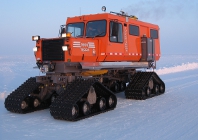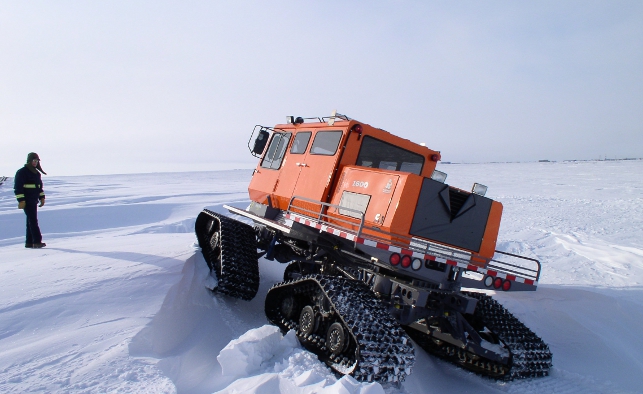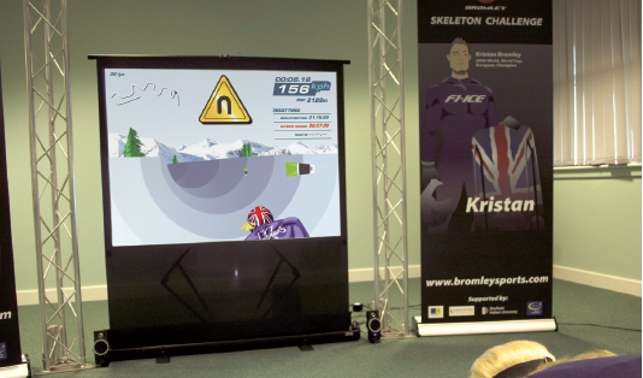Snow deep, mountain high
Tucker Sno-Cat have been producing tracked vehicles for three generations now, and with that level of experience you know they’re going to be tough through heritage.
Its giant, orange, monster machines are made for heavy workloads over terrain that even a heavily customised 4×4 truck would throw-up its breakfast at. A typical four-track Sno-Cat, despite having the ruggedness of a bear-wrestling lumberjack, is designed to simulate a standard pickup truck, with steering wheel, foot throttle, foot brake, etc.
By using conventional automotive controls it allows an inexperienced driver to operate it with a minimum amount of instruction.
Everything else is specially designed for the hardships of bleak snowy landscapes: hydraulic steering through pivoting both the front and rear axles; smooth movement over the terrain and constant four-point drive from its special rubber tracks, an advantage when maneuvering on sidehills and giving it a light footprint.
The front and rear tracks present a fan pattern on the terrain as the vehicle turns or crabs on a sidehill. This is a major factor in preventing ‘side slip’ on ice or hard faced slopes.
“Autodesk Inventor Professional 2011, AutoCAD, and Algor FEA,” lists Sno-Cat mechanical designer Albert Allen as the CAD tools they use to create this beast. “One of the ways we utilise the software is when sales have a request for a specialised application vehicle or implementation
“We use Algor FEA for hot spot identification along with Algor MES (mechanical event simulation). With the MES software we are able to simulate dynamic loading that was previously not possible”.
An example of this would be simulating the plow blade striking a tree while trail grooming – apparently quite a common mishap on the slopes – but it will give you peace of mind for when looking for wolverines to wrestle with this winter.
www.sno-cat.com
Home and dry
Don’t fancy stepping out into all that cold, inhospitable, ice and snow? Fear the bumps, bruises and fatal breakages? Don’t worry.
Taking to the fearsome skeleton bobsleigh requires calculated moves, split-second reactions, and balls of something much tougher than steel; so suppliers to the British Olympic team, Bromley Athlete Engineered Technology, have built a super-realistic simulator.
The sport, which uses the same levels of technology as aerospace and Formula1, is highly reliant on the abilities of its engineers to build the fastest sleds – with this technology being passed over into the simulator for a highly realistic ride.
Used as an educational platform to inspire the next generation of engineers, scientists and athletes ‘The Skeleton Challenge’ is taken around the world to promote engineering, science and technology using the Olympic sport as an example.
“We have been designing, developing, manufacturing and racing Skeleton Bobsleighs for over 15 years so we took this knowledge to create a stylised sled and a platform to mount it to,” says Bromley design director Dan Fleetcroft.
“After the initial ideas were discussed and refined the Simulator was fully modelled in 3D CAD, where all the engineering details, such as manufacturing techniques for the various components and the control mechanism, were defined.”
True to the team’s heritage of working in Formula1, they used every piece of software they could get their hands on: Pro-Engineer, Unigraphics, NX and Catia for starters, not to mention the FEA analysis to ensure loads could be supported. The sled was produced by Bromley’s technology partner Materialise in the form of Fused Deposition Modelling (FDM) parts.
“The task of producing a low volume (currently three) fully functional, aesthetically styled and finished component that is lightweight, robust, and finished to a high standard, but without the requirement of expensive tooling is certainly a challenge,” says Dan.
Fresh back from a trip to Canada the simulator has already been ridden by over 8,500 children in its first few months. All of them without any crashes.
www.bromley-aet.com

Travelling on ice, both in the great outdoors or indoors








